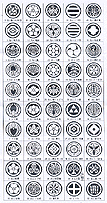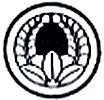| Go to Gallery |  |
Go to Alphabetical Index |
|
(Kamon) Wikipedia : "Kamon" click HERE |
|||||||||
 Open new window for larger picture |
Like the heraldic devices of Europe, Japanese family crests
developed as the battlefield insignia of feudal nobles and warriors during the
12th century. Over time they were adopted and altered by institutions,
businesses and the common people. The subdued, monochromatic crests draw from a
number of simple motifs- mostly animals and insets, natural phenomena, abstract
designs, symbols and ideographs, man-made objects, and plants. They range from
quite literal depictions-an anchor or a fan, for instance-to highly stylized
ones, such as Mr. Fuji in the mist. Crests are still a valued part of Japan's
aesthetic wealth, and virtually every Japanese family has one, although most now
display these elegant symbols only during formal occasions.
|
||||||||
|
More about Kamon
|
|||||||||







